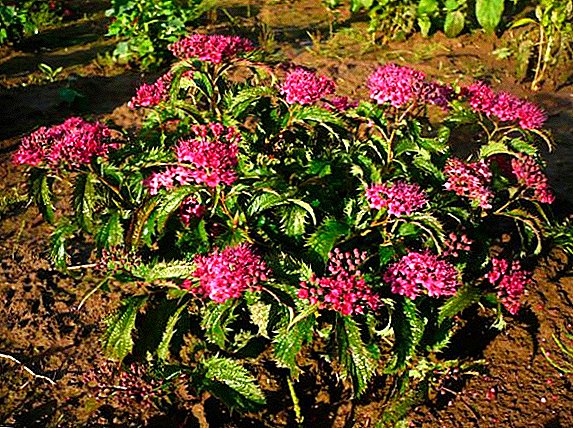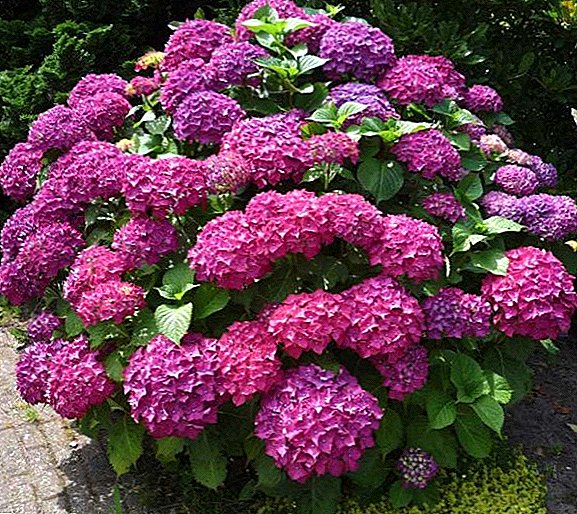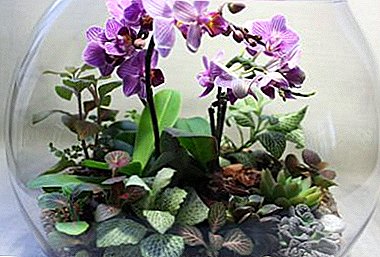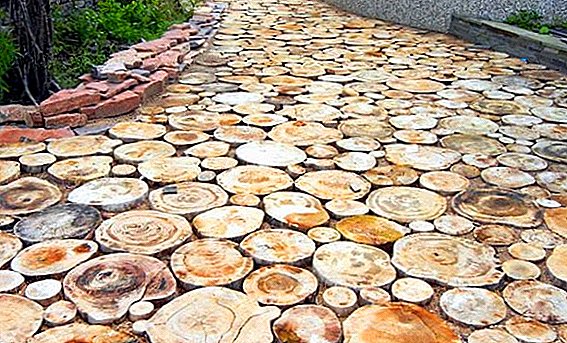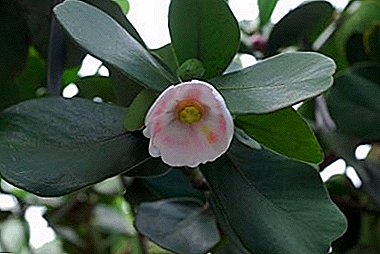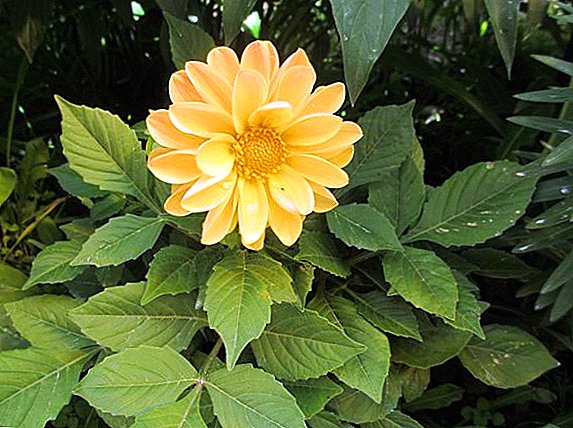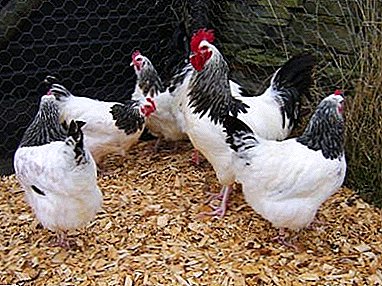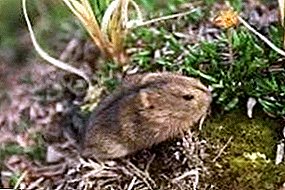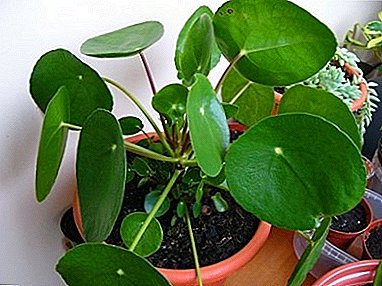
The leaves of the Peppy and Pepper are like large coins dangling from a tall stem.
Apparently, therefore, it is called the "Chinese money tree".
Plant description
“Pilea Peperiomatous” is a representative of the genus of more than four hundred species. It belongs to the family of nettle. By origin, it is from India, also distributed in western China. As a room grown started relatively recently, it appeared in Europe in the forties of the last century.
The height of the plant is 30-40 cm. In the center of the bush is a stalk from which the leaves hang on elongated petioles. Rounded leaves have a glossy surface. Sometimes it blooms with small red flowers, but this is only subject to the rules of winter care.
"Peperus Pepper-shaped" is a rather unpretentious plant: drought-resistant and cold-resistant.
A photo
The photo shows “Peileo Pepper” with proper care at home:




Home care
"Pepeoids Peperium-shaped" can be grown as a regular pot culture, as an ampelous flower in wall pots. An interesting variant of its cultivation as a groundcover flower in tubs with tall potted trees. The most detailed information about caring for the Pylaea family can be found here.
Actions after purchase
 After purchase, the plant should be immediately freed from the transport substrate and transplanted into a wide, shallow container.
After purchase, the plant should be immediately freed from the transport substrate and transplanted into a wide, shallow container.
The soil is made up of leaf turf, humus, peat and sand (3: 1: 1: 1).
You can use the finished soil from the sale of decorative leafy plants.
Lighting
Keep the “Pilea” in a well-lit place, but take care of the sun, as its delicate leaves can easily get burned.
Important! Excessive light "Sawing" is harmful, from his leaves lose color. Keep it should not be on the windowsill, and at some distance from the window.
Temperature
A native of warm countries, “Pilea” is quite thermophilic, but keeping it at normal room temperature is also suitable for it. It is only necessary to protect it from drafts. In summer, you can keep a flower on the balcony or even outside.
Watering and humidity requirements
Watering "Piley" is designed to provide a constant, moderate soil moisture. Substrate drying cannot be allowed. But dryness is less detrimental to it than waterlogging. Too much moisture contributes to root decay.
 Humidity of air "Pilaye" is necessary increased.
Humidity of air "Pilaye" is necessary increased.
But to spray her experienced growers are strongly discouraged, it will look untidy.
To maintain the humidity is better to use other ways.
Put the pot in a pan filled with expanded clay and filled with water.
The bottom should not come into contact with water. The use of a humidifier is also ideal during the heating season.
If your “Pilea” is grown in a suspended pots, you can put the pot in a container of larger diameter and impose it on wet moss.
Top dressing
Every 14-15 days, feed the plant with a universal fertilizer for indoor plants. Fertilizer should be carried out after light irrigation, so that minerals penetrate well into the soil and not be absorbed into the upper layer.
Pruning
With the development of this flower quickly loses its decorative, on this basis, it should be regularly cut.
Cut stems are used for grafting. The main stalks need to pinch to stimulate the growth of new shoots.
Content in winter
This type of "Piley" feels great with rare watering and ten-degree temperature. If you create such conditions for her, in the summer she will give you flowering. Although the flowering of this plant is nothing special. Her flowers are small, collected in small inflorescences.
In winter, it is necessary to reduce not only watering, but also fertilizing. It is necessary to fertilize a plant in the winter once a month.
Transfer
 Peileo Pepper loves spacious pots so that the roots have a place to grow.
Peileo Pepper loves spacious pots so that the roots have a place to grow.
It should be transplanted annually in a light, neutral or slightly acidic soil.
During transplantation, to prevent growth and loss of decoration, the top shoot is cut.
The plant will give side shoots and will not reach up.
At the bottom of the pot you need to lay a sufficient layer of drainage mixture to prevent over-wetting of the roots.
Breeding
Cuttings
The easiest "Pilea" breeds cuttings. Carry out cuttings year-round, as the roots of this plant forms very easily. The cut stalk is placed in a wet substrate or in a mixture of sand and peat. As soon as new processes appear on the handle, they are transplanted into suitable dishes.
Important! During rooting, the cuttings should be covered with a transparent cap to create a greenhouse effect.
Seed method
For seed multiplication, use flatware.filled with a mixture of peat sand and sod land. Seeds are laid out on the surface, moistened with a spray bottle and cover the container with glass or film. Germination should be carried out in a warm, bright place. Crops are regularly aired.
Seeds of "Pilea" germinate unevenly, the process can take up to 50-60 days. When the first germs appear, the glass is removed and germination continues in open form. Plants with three or four true leaves dive into separate pots.
Beneficial features
Flower growers noticed the effect of creating a favorable energy for this plant when growing it at home. It reduces anxiety, relieves fatigue and improves mood.
- Cadier;
- "Monetolist".
Diseases and pests
 Like most houseplants, "Pilea" is affected by a mealy worm, spider mite, thrips.
Like most houseplants, "Pilea" is affected by a mealy worm, spider mite, thrips.
Their reproduction is provoked by dried air in the room where the flower is contained.
Carefully inspect the plant and if you notice white bloom on the leaves, sticky surface or white and brown dots, begin processing.
It is necessary to rinse the leaves with warm water and treat with insecticides.
Diseases "Pylei" can signal some external signs:
- Shriveled leaves indicate an elevated or opposite lowered temperature;
- Blackened and soft leaves - waterlogging, sometimes in combination with low temperature. Under such conditions, the roots begin to rot;
- Yellow or brownish stains - burns;
- Lightening leaves speaks of excessive illumination. The plant should be removed away from the window.
- The fall of the lower leaves - the aging of the plant. If the lower part of the plant is exposed, you need to rejuvenate the "Pile". You can plant cuttings to get a new copy.
Universality of cultivation: as an ampel or ordinary indoor flower - it gained popularity among gardeners. "Pilea" is growing rapidly and does not require special care, so even inexperienced growers deal with its cultivation.


